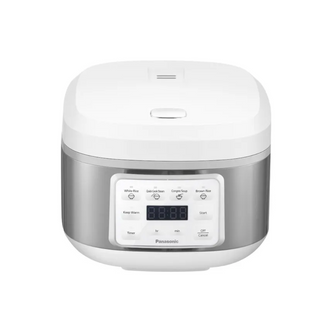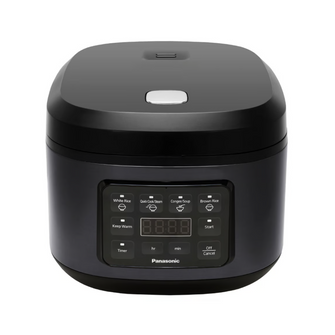Rice is a staple for countless households all over the world. There's a good reason for that, rice is delicious and satisfying, filling, hearty and healthy. Rice can also be notoriously difficult to cook well.
Perfectly cooked rice should have a light, fluffy texture with separate, non-sticky grains. Undercooked rice can be crunchy and hard, while overcooked rice can become mushy and unappetizing. Have you ever burned rice? I have. You don't want to be me.
Enter the rice cooker. If you eat rice frequently, or you want to start eating rice frequently, you need a rice cooker. A rice cooker will help you cook all different types of rice perfectly, every time.
How does a rice cooker work?
A rice cooker is a specialized kitchen appliance designed to automate the process of cooking rice. It works by heating a cooking pot and regulating the temperature to ensure that the rice is cooked perfectly every time.
Rice cookers work by controlling the temperature and moisture in the pot. They typically consist of an outer insulated housing, an inner cooking pot, a heating element, and a thermostat. The inner pot is where the rice and water are placed, and it is heated by the heating element underneath.
The thermostat plays a crucial role in the cooking process. It monitors the temperature inside the pot and automatically adjusts the heat accordingly. When the water starts boiling, the thermostat reduces the heat to a lower setting, allowing the rice to simmer and absorb the remaining water.
Once the water has been fully absorbed, the thermostat switches the cooker to a warm setting, keeping the rice at an ideal serving temperature.
Pros and cons of a rice cooker
Pros:
- Hands-Free Cooking: Once the rice cooker is cooking you can leave it alone and go about your day.
- Consistent Results: Follow the directions and you'll get perfect rice every single time.
- Versatility: Cook all types of rice, congee, quinoa, beans, pasta, barley, even soup.
- Energy Efficiency: A rice cooker will use less power than the stove.
- Safety: Safer than leaving a pot boiling on the stove. Many models come with safety features like auto shut off and cool touch exterior.
- Convenience: Set and forget!
Cons:
- Any small appliance will take up space on the benchtop.
- Any new appliance will cost money, stay within your budget friends!

How to use a rice cooker
As with all appliances, refer to the manufacturer instructions that came with your model. Here's the general gist of it.
Step 1: Rinse rice
Thoroughly rinse and strain the rice in cold water, repeating this process at least twice until the water appears clear. This will stop the rice from sticking together. Drain as much water off as possible.
Step 2: Add water
Put the rice into the pot and add the recommended amount of water. It's important to carefully follow the water-to-rice ratio recommended for your model to get the best results.
Step 3: Start the rice cooker
Close the lid and press the start button. Depending on your model you might need to select a program or timer.
Step 4: Fluff the rice
When the rice cooker has finished cooking, open the lid and fluff the rice.
The rice is done when the cooker automatically switches to "warm" mode. You can also check by tilting the inner pot – if no water remains pooled at the bottom, the rice is ready.
For perfect rice every time, follow the recommended rice-to-water ratios and don't lift the lid during cooking. Most cookers have a steam vent, so you can check progress without removing the lid.
Resist the urge to stir the rice while cooking.
Step 5: Clean up after yourself
Once you've removed the rice, wash the inner cooking pot straight away or set it to soak in the sink to make sure no rice grains stick to the inside.
Most rice cookers will come with a non-stick coating on the inner cooking pot. Take care not to scratch the pot when cleaning, use a soft sponge and avoid using metal utensils.
Avoiding Common Mistakes
When cooking rice in a rice cooker, there are a few common pitfalls to avoid to ensure perfectly cooked, fluffy grains every time.
Rice is uneven: Make sure the rice is level in the pot so the water can saturate the grains evenly.
Rice is sticky: Make sure you're rinsing the rice thoroughly before cooking to remove excess starch. Use the correct water-to-rice ratio. Avoid lifting the lid during cooking or steam will escape. Finally, fluff the rice immediately after cooking to release steam and separate the grains.
Using metal utensils: Most rice cookers have a non-stick coating on the inner pot, using metal utensils may damage the coating. Stick to wooden or plastic.
Only cooking rice: You can cook loads more in the rice cooker than just rice!
Beyond rice
Here's a list of other things you can cook in the rice cooker.
- Quinoa
- Barley
- Lentils
- Porridge
- Polenta
- Beans
- Soup
- Hard and soft boiled eggs
- Cake
- Pasta
You can also use your rice cooker like a slow cooker to make one pot meals, and like a steamer to make steamed fish and vegetables. Of course, you can also use it to make risotto.
You can use the keep warm function to proof breads before baking.
You can even use it to make hot chocolate or mulled wine.
Rice Cooker Mushroom Risotto Recipe
Here's a delicious recipe courtesy of Marion's Kitchen
Ingredients
- 3 dried shiitake mushrooms
- 2½ cups chicken stock, hot
- 1 cup carnaroli or arborio risotto rice
- 3 garlic cloves, finely chopped
- 1 onion, finely diced
- 3 tbsp unsalted butter, diced into small cubes, plus 1 tbsp extra for serving
- 4 sprigs thyme, leaves picked
- 100g (3.5 oz) mushrooms, thinly sliced (I like to use Swiss brown and enoki)
- 3 tsp sea salt
- ½ tsp ground black pepper
- 2 cups baby spinach
- ¾ cup frozen peas, thawed
- ½ cup freshly grated parmesan cheese
- finely grated zest of 2 lemons
- extra virgin olive oil, to serve
Method
- Place the shiitake mushrooms into a large bowl. Add the chicken stock and allow the mushrooms to rehydrate for 20 minutes. Remove the mushrooms, reserving the chicken stock for later, and gently give them a squeeze to remove any excess liquid. Use a knife to remove and discard the stems, then thinly slice the mushrooms.
- Place the rice, garlic, onion, butter, thyme leaves, all the mushrooms, salt and pepper into the rice cooker. Pour in the hot chicken stock as well as the mushroom soaking liquid, give everything a stir and then close the lid. Select the White Rice button and allow to cook for the automated time.
- Once the rice cooker is done, stir through the remaining 1 tablespoon of butter, the spinach, peas, parmesan and lemon zest. Divide among serve bowls, drizzle with olive oil and serve (you can also use the Keep Warm function in case you want to go back for second helpings!).
Notes
- This recipe was made using the Panasonic 8-Cup Rice Cooker SR-DA152WST. Way more than a rice cooker, it’s a multi cooker that can create many different dishes, like this risotto.






